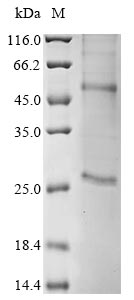This recombinant Human coronavirus NL63 Membrane protein (M) is produced through an in vitro E.coli expression system, yielding a full-length protein of 226 amino acids. The protein carries an N-terminal 10xHis tag, which helps with purification and detection processes. SDS-PAGE analysis confirms a purity exceeding 85%, making it well-suited for various research applications in viral protein studies.
The Membrane protein (M) of Human coronavirus NL63 appears to be a crucial component of the viral envelope. It likely plays a fundamental role in virus assembly and morphogenesis. As an integral membrane protein, it interacts with other structural proteins and contributes to viral particle formation. Understanding the M protein's structure and function may be essential for advancing coronavirus biology research and developing therapeutic strategies.
Potential Applications
Note: The applications listed below are based on what we know about this protein's biological functions, published research, and experience from experts in the field. However, we haven't fully tested all of these applications ourselves yet. We'd recommend running some preliminary tests first to make sure they work for your specific research goals.
Human coronavirus NL63 Membrane protein (M) is a triple-pass transmembrane protein whose native structure and function depend on integration into a lipid bilayer. While the in vitro E. coli expression system improves solubility and may support disulfide bond formation, it cannot provide the necessary membrane environment for proper tertiary and quaternary structure formation. The protein may be soluble and contain correct disulfide bonds, but it will lack the transmembrane topology and spatial organization found in viral membranes. The probability of achieving native-like structure and function in solution is low.
1. Antibody Development and Characterization
This application is highly suitable as antibody development primarily relies on antigenic sequence availability rather than native membrane insertion. The full-length protein provides comprehensive epitope coverage for generating antibodies against various M protein regions. Antibodies may recognize both linear and some conformational epitopes, though membrane-dependent epitopes may not be faithfully represented.
2. Biochemical Characterization and Stability Studies
These studies are valuable for assessing the protein's solution properties, but cannot reflect its native membrane-bound state. Techniques can analyze disulfide bonding, oligomerization in solution, and general stability, providing important biophysical data for this specific preparation.
3. Immunoassay Development and Validation
This application is well-suited as immunoassays depend on epitope recognition rather than native conformation. The protein can serve as a reliable standard for detecting anti-M protein antibodies in research assays.
Final Recommendation & Action Plan
The cell-free expressed M protein is primarily suitable for applications that don't require native membrane integration, such as antibody production (Application 1), immunoassay development (Application 3), and biophysical characterization (Application 2). For interaction studies, use with caution and only for investigating potential interactions with soluble viral components, always validating findings with native systems. Avoid any applications requiring authentic transmembrane topology or membrane-dependent interactions. Begin with a comprehensive biophysical characterization to understand this specific preparation's properties, then proceed with antibody and assay development. For studies requiring native M protein function, use membrane-incorporated protein or virus-like particles.






